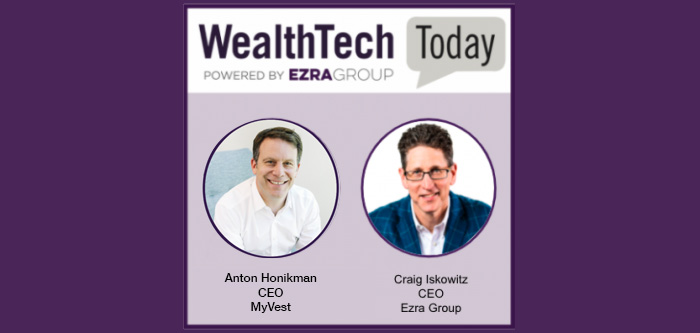By Anton Honikman, MyVest CEO
To date, the digital wealth movement has targeted scale through simplified off-the-shelf investment offerings and high volume paperless enrollment.
But the sands are shifting. The “one size fits all” approach is soon to be a dinosaur.
This concept was the cornerstone of a panel I recently spoke on at Converge: The Robo-Advisory Forum, entitled “Different Strategies to Appeal to Different Segments: Millennials, Hispanics, Boomers, and HNW.” The panel also included Kai Stinchcombe, Founder & CEO of True Link Financial, a robo advisor focused solely on retirees, as well as Manuel Carvallo, President of Hispanic Wealth, a consulting company focused on serving the wealth-creation needs of Hispanics in the US.
When so much of investment management is becoming commoditized (through ETFs and basic asset allocation strategies), there’s a need for digital wealth providers to differentiate their offerings to stay relevant and competitive. All of this points to the rise of personalization in response to this commoditization, the recognition that the needs of distinct categories of consumer are quite different.
Today’s providers are dipping their toes in the water by beginning to include value-add services like retirement calculators, lightweight financial planning, tax managed portfolios, and hybrid service delivery.
What we’ve seen has been a slow evolution from B2C robos simply offering investments toward offering real advice.
This is supported by the recent popularity of the hybrid service model, the combination of the efficiency of a digital platform with the personal touch of human beings. This evolution was pioneered to a large extent by our customer Personal Capital, and is now being embraced by larger digital advice offerings like Schwab, Vanguard, and TIAA.
The Drive Toward Hyper-Personalization
So what is this evolution a response to? It’s about the imperative to stay relevant to the needs of different types of investors, as both commercial and regulatory forces will require it. Investors’ goals, values, and preferences are influenced by their demographic segment, life stage, household balance sheet, and specific tax circumstances.
To act in your customers’ best interests your advice needs to be cognizant of these factors. Your platform has to be relevant to the particular audience you’re serving. For example:
Millennials may be saving for a down payment on their first home, whereas retiring boomers care about extracting equity from their home to fund retirement income;
Mass affluent investors care about longevity risk of their retirement savings, while high net worth investors care about tax efficient inter-generational transfer of wealth, and are not bothered by longevity risk.
True Link’s Kai Stinchcombe dug deeper on retirees and near-retirees, whose needs are more complex than managing retirement income. They’re looking at not only lifestyle preservation, but also healthcare directives, living wills, tax management, annuities, and long-term care.
And according to Hispanic Wealth’s Manuel Carvallo, Hispanic investors make up a material portion of the investable assets in the US, yet are historically underserved by the financial services industry. He cited cultural, language and financial literacy issues endemic in the Hispanic demographic that are not being catered to by traditional advisory firms. He specifically raised this as an opportunity for a B2C robo to personalize their offering for Hispanics.
The Opportunity for You to Personalize Advice
While there’s certainly an opportunity for disruptor firms to find their niche, incumbents with large customer bases (i.e. large banks) also have the opportunity to segment their addressable market to create personalized experiences for each cohort. And with access to large volumes of data, they have the ingredients to support a micro-targeted solution to individuals based on a granular profile.
The next generation of digital wealth won’t just be personalized, but hyper-personalized.
I imagine that the future of digital wealth management will personalize every step of the journey for each investor, much like Bill Gates’ famed tech-heavy home: upon arrival each guest is given a pin that interacts with sensors in each room of the house, so as they make their way through the house the temperature, music, lighting, and even the artwork adjust to accommodate their specific preferences.
For now we see firms like True Link Financial and Ellevest filling the gap that broad-based digital wealth providers have left open. Eventually that gap will be increasingly filled by incumbents using technology to serve more specific needs.
The entire advice ecosystem will be driven by sophisticated analytics enabling micro-targeting at scale. This will power the next generation application of digital engagement, prospecting tools, investment solutions, and content management systems to personalize the entire experience for targeted customer profiles.
Of course, the industry isn’t quite there yet. But the winners will embrace these tenets.
Personalized experiences in wealth management will rule the day. But you can’t achieve that differentiation without the right technology. Learn how our Strategic Portfolio System can help your organization through personalizing investment solutions at scale.
Read Anton’s original post on LinkedIn.


![MyVest Byline: The Evolution of the UMA from 1.0 to 3.0 [Wealth Management]](https://myvest.com/wp-content/uploads/wealth-management-logo.webp)


![MyVest CEO Sees a Tech-Enabled Future Rapidly Approaching [PlanAdviser]](https://myvest.com/wp-content/uploads/PlanAdvisor-Anton-interview-May-2021.jpg)
![We Can Do Better: Making Financial Wellness a Workplace Imperative [BenefitsPRO]](https://myvest.com/wp-content/uploads/MyVest-FacetWealth-financial-wellness.jpg)